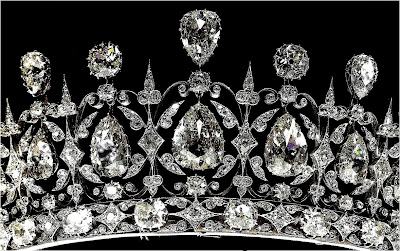#3. The Fife Tiara
Coming in at number three, we have a tiara that hasn't been seen in public for a long, long time. And unless following the many and varied descendants of Queen Victoria is a personal hobby of yours, there's a good chance you're not that familiar with its wearers. But never mind that. Just loooook at it:
 |
| The Fife Tiara |
The Fife Tiara is the third tiara on your list to hail from a noble family, but this time we have a royal beginning. It first belonged to Princess Louise of Wales, the oldest daughter of King Edward VII and Queen Alexandra. When she married the Earl of Fife in 1889, she received quite a waterfall of sparkling presents; this stunning tiara with pear-shaped diamonds hanging freely in a diamond framework, topped with more pear-shaped diamonds alternating with round diamonds, was among them. It is thought to be the work of Parisian jeweler Oscar Massin. This is sometimes said to have been a gift from her parents, but contemporary reporting of her wedding gifts attributed it to the Earl (who was made the Duke of Fife by Queen Victoria right after the wedding). Her parents' gift, on the other hand, is described as a classic convertible diamond fringe tiara.
 |
| Princess Louise, the Princess Royal and Duchess of Fife |
Poor Louise is something of a background figure in royal history. She wasn't as pretty as her mother or her sister, Victoria, and she wasn't as notably married as her sister Queen Maud of Norway. Apparently a rather difficult person to make conversation with, she earned herself the title "Her Royal Shyness" and was most known for her talents in the realms of music and fishing. Her marriage to the Duke, who was 18 years older, seems to have done her a world of good - as, no doubt, did the escape from the smothering atmosphere of her parents' home. She was one of the first princesses to marry a subject rather than a prince but Queen Victoria approved of the union, noting that the groom was extremely rich.
 |
| Princess Louise |
Louise was given the title of Princess Royal, but didn't play a large role in the royal family. Her ill health was a continual problem, and she escaped to warmer climates each winter. While en route to Egypt for the winter of 1911, the Fife family was shipwrecked off the coast of Morocco. Though they all survived, the ordeal took a toll on the Duke's health, and he passed away the following month.
 |
| The Duchess of Fife (left - wearing the Fife Tiara and the fringe tiara from her parents around her neck) and Queen Alexandra (right - wearing the kokoshnik tiara now worn by Queen Elizabeth) with Alexandra's mother, Queen Louise of Denmark (center) |
Louise had three children: a stillborn son followed by two daughters, Alexandra and Maud. Because it was known in advance that there would be no Fife son to inherit the title, Queen Victoria made a special dispensation for inheritance in the female line. Accordingly, Princess Alexandra became the Duchess of Fife in her own right when her father died. Later she was also known as Princess Arthur of Connaught through her marriage. As she was predeceased by her own son, the title passed down to her nephew, James Carnegie. So far as we know, the tiara is still with the family.
 |
| Princess Alexandra, Duchess of Fife |
Tiara occasions for the Fifes are very rare, which is terribly sad for us jewel lovers. This one in movement would be absolutely spectacular. Mounted in gold and set in silver, the largest diamonds freely articulate inside their diamond arches. That means that they would tremble with the tiniest movement of the wearer's head, capturing and reflecting the light constantly.
 |
| Caroline, Countess of Southesk, daughter-in-law of the current Duke |
This has always been a favorite of mine. It has enormous individual stones and the design is very spiky, like a Gothic fence of some sort (the prettiest Gothic fence
ever). And yet, I think
delicate is a perfectly applicable word to describe it. That's what's remarkable about this, what makes it a triumph of workmanship and design, really: it retains a certain lightness despite the staggering carat weight on display.
Quite frankly, I find it breathtaking - especially at first glance. I'm not at all surprised that this made it so high on the list, even with a low-key history and essentially no contemporary outings and no well-known wearers.
Did you know about this tiara prior to our little voting extravaganza, or are you a new convert?Photos: Geoffrey Munn/The Royal Collection







No comments:
Post a Comment